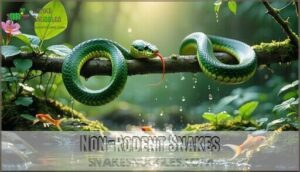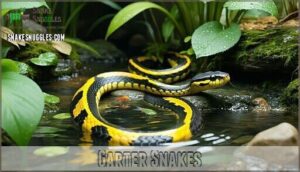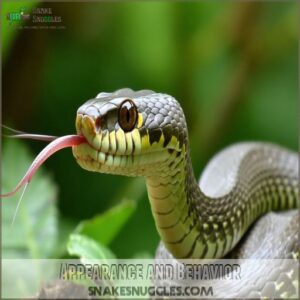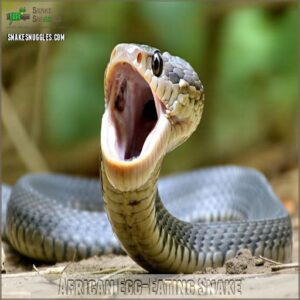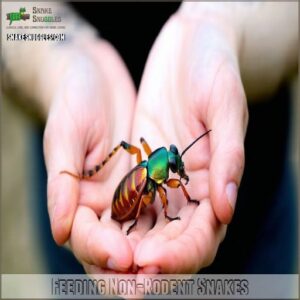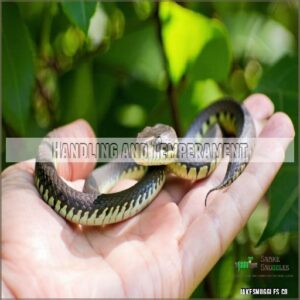This site is supported by our readers. We may earn a commission, at no cost to you, if you purchase through links.
 You bet there is a pet snake that can’t eat mice! Meet the garter snake, an excellent choice if rodents make your skin crawl. These snakes thrive on a diet of fish, worms, and insects, making them a less squeamish pet option.
You bet there is a pet snake that can’t eat mice! Meet the garter snake, an excellent choice if rodents make your skin crawl. These snakes thrive on a diet of fish, worms, and insects, making them a less squeamish pet option.
Imagine telling your friends you’ve got a snake that skips the mouse buffet!
Similarly, ribbon snakes and water snakes prefer fish and amphibians.
If you’re feeling adventurous, consider the African egg-eating snake, which munches exclusively on bird eggs.
Curious about setting up the perfect home for these fascinating creatures? Stick around for some handy tips and tricks!
Table Of Contents
- Key Takeaways
- Is There a Pet Snake That Cant Eat Mice?
- Non-Rodent Snakes
- Garter Snakes
- Ribbon Snakes
- Water Snakes
- African Egg-Eating Snake
- Non-Rodent Diets
- Pet-Friendly Non-Rodent Snakes
- Feeding Non-Rodent Snakes
- Habitat and Enclosure
- Handling and Temperament
- Frequently Asked Questions (FAQs)
- Do snakes eat mice?
- Do snakes eat rodents?
- Why is it hard to feed mice to snakes?
- Do blind snakes eat mice?
- Do green snakes eat mice?
- Do sea snakes eat rodents?
- Can you have a pet snake and not feed it mice?
- Are there any snakes that don’t eat meat?
- What can I feed my snake if I don’t have mice?
- Do vegetarian snakes exist?
- Conclusion
Key Takeaways
- You can have a pet snake without feeding it mice; species like garter, ribbon, and African egg-eating snakes prefer fish, insects, or eggs.
- Garter snakes are low-maintenance pets that eat insects, fish, and earthworms, eliminating the need for rodent diets.
- African egg-eating snakes exclusively eat bird eggs, showcasing a unique dietary habit among non-rodent-eating snakes.
- Setting up the right habitat with proper temperature, humidity, and substrate is essential for the well-being of these non-mouse-eating snakes.
Is There a Pet Snake That Cant Eat Mice?
Pet snakes that don’t eat mice? Absolutely, and it’s not just rare magic! Many snake species thrive on a non-mammalian diet, making them great companions for those worried about feeding them rodent meals.
Garter snakes, ribbon snakes, and some water snakes are popular choices that manage perfectly well without mice morsels.
If you’re considering these alternatives, you can find suitable snake food alternatives online.
Instead, they munch on a varied menu of insects, fish, or amphibians, offering a tasteful twist to typical snake care.
So, if the idea of dishing out mice makes you squirm, these species present a viable, more comfortable option.
Explore a world where ethical concerns and dietary variety lead to snake safety and owner comfort.
Non-Rodent Snakes
Looking for a slithery friend that doesn’t munch on mice?
Enter the realm of non-rodent snakes! These unique serpents, like garter and ribbon snakes, offer a fascinating alternative to traditional pet snakes.
They’re not all fangs and fury; some enjoy a diet rich in insects, worms, and small fish. For something truly unique, consider the African egg-eating snake, which thrives on bird eggs.
These critters are perfect for those who shy away from rodent feeding.
With proper care, you’ll find that these non-mammalian snake diet options result in enchanting pets.
So, whether you’re aiming for ethical sourcing or exploring reptile rescue and breeding programs, these snakes fit the bill perfectly.
Garter Snakes
Garter snakes make excellent pets if you’re looking for a non-mouse eater.
They thrive on a diet of insects, fish, and earthworms.
You won’t need to worry about scary mice here; just watch your snake happily slither along its terrarium.
Care and Feeding
Garter snakes thrive on a varied diet. Offer them worms, crickets, and small fish, steering clear of rodents.
Feed them in a secure spot to keep nips at bay.
Keep their environment pleasant and toxin-free. Supplements and feeding frequency adjustments help them remain healthy.
This routine makes them great for those seeking low-maintenance, non-mouse-eating pet snakes.
Habitat Requirements
Crafting a snug habitat for your garter snake isn’t rocket science.
Start with a 20-gallon terrarium for ample room to roam and stretch out.
Use aspen shavings, cypress mulch, or coconut fiber for the substrate. When choosing a substrate for burrowing, opt for a deep option like coconut fiber bedding.
Toss in a few cozy hides to help them feel secure, particularly during shedding.
Maintaining stable temperature and humidity is essential for their snake happiness!
Ribbon Snakes
Ribbon snakes, with their sleek bodies and striking stripes, might remind you of a living ribbon gliding gracefully.
They’re not picky eaters, feasting happily on small insects and fish, and sometimes a tiny mouse snack.
making them an easy-care option for pet owners.
Appearance and Behavior
Spotting a ribbon snake is like finding a tiny, elegant jewel in the grass. Their long, slender bodies, usually under two feet, are adorned with striking body patterns.
If you’re interested in welcoming one into your home, you can find them for sale at various online retailers, like those listed on sites such as this ribbon snake seller.
These shy creatures, though initially timid, mellow with gentle handling. Their defensive tactics involve hiding, but they’re not aggressive.
You’ll find temperament variations, but generally, they’re docile snakes, making them perfect non-mouse-eating pets. The shedding process is typical of snakes.
Their movement style is sinuous and graceful.
Diet and Feeding
Feeding ribbon snakes can be a real adventure.
These little guys love a varied diet of crickets, waxworms, and mealworms, similar to their wild diet of frogs and small fish.
Make sure to gut load insects with healthy foods and dust them with calcium and vitamin D3 supplements.
Offering live prey can spark their hunting instincts.
Mix it up with small fish or earthworms to keep their nutritional needs met.
Water Snakes
If you’re looking for a snake that skips the mice, water snakes might be your splash of success.
These aquatic reptiles prefer meals like fish and frogs,
though they can be a bit more assertive than their land-loving cousins.
Species Overview
Water snakes bring an underwater twist to the pet snake scene.
Check these out:
| Species | Size Range | Native Region |
|---|---|---|
| Graham’s Crayfish Snake | 1-3 feet | Southeastern US |
| Diamond-Backed Water Snake | 2-4 feet | Eastern US |
| Brown Water Snake | 2-4 feet | Central/Eastern US |
Their size variations and unique habitats make them fascinating additions to the nonmouse-eating snake family.
Feeding Habits
Regarding feeding your water snake, don’t worry about mice.
These snakes are experts at snatching up aquatic fare like small fish and frogs.
Their digestive system is perfectly suited for this lifestyle, which is why a varied diet including live fish and thawed frozen fish is recommended for the best health.
To keep your pet thriving, remember to offer a varied diet, adjust prey size accordingly, and consider dietary supplements.
It’s the secret to a happy, healthy snake!
African Egg-Eating Snake
If you’re looking for a pet snake that doesn’t feast on mice, the African egg-eating snake fits the bill perfectly.
This fascinating reptile has a mouth adapted to swallow big bird eggs whole, which sounds like a magic trick because they don’t even have teeth!
Unique Adaptations
Imagine a snake that dines solely on eggs, specifically belonging to the Dasypeltis genus, which has specialized teeth for tearing through eggshells as discussed in Egg Eating Snake Care.
The African egg-eating snake is crafted perfectly for this feast.
With jaws that stretch wide, it swallows eggs whole, then uses it’s totally harmless—no need for venom here.
Make sure your slithery buddy’s health by supplementing with vitamin B1 to support strong bones.
Captive Care
An African Egg-Eating Snake’s happy life needs the right setup.
You’ll want a comfy enclosure with ideal temperature and humidity.
Feed it pre-killed quail eggs.
Regular vet checkups are a must.
Remember, these snakes are fascinating, low-maintenance pets for reptile enthusiasts.
Proper care guarantees a long, healthy life for your scaly friend.
Non-Rodent Diets
You might be surprised to learn that some pet snakes can thrive on a diet of insects, fish, and even eggs instead of mice.
Understanding these non-rodent diets will help you provide your slithery pets with the varied and balanced nutrition they need.
Insect Feeders
Insect feeders offer a great pet snake option that skips mice.
Garter, ribbon, and water snakes enjoy meals of crickets, mealworms, and waxworms.
It’s like giving them a healthy buffet!
Stick to tongs for crickets or dishes for mealworms, making feeding straightforward.
Balanced and easily accessible, this diet fits perfectly for anyone keen on keeping snakes without rodent diets.
Fish and Amphibian Eaters
When you’re exploring the realm of non-mouse-eating snakes, the fish and amphibian aficionados shine bright.
These snakes, with a taste for fish species like guppies and amphibian prey such as frogs, offer a fascinating dietary shift.
You can find a variety of frog snake food options online to make sure your pet gets the right nutrition.
Just watch out for fish with thiaminase, which they can’t digest.
With the right tank setup and care, you’ll keep these aquatic adaptations thriving!
Pet-Friendly Non-Rodent Snakes
If you’re looking for a snake that won’t make you deal with mice, consider the friendly garter and ribbon snakes.
They feast on insects and worms, making them both low maintenance and fascinating pets.
Garter Snake Species
Though garter snakes mightn’t be the rock stars of the reptile world, they shine as fantastic pet snakes for those not keen on feeding rodents.
These non-mouse-eating snakes enjoy a diet of insects, worms, and small fish.
Known for their resilience, garter snakes can be easily bred.
Just watch out during hibernation—they might get a bit cranky!
Ribbon Snake Species
Ribbon snakes, one of nature’s jewels, make delightful non-mouse-eating pets.
With their vibrant colors and gentle demeanor, they’re easy to care for and love dining on insects and fish.
These charming snakes don’t need rodents to thrive, simply a well-kept habitat and consistent care.
Like their garter snake cousins, ribbon snakes are enchanting companions.
Feeding Non-Rodent Snakes
You’ll discover that feeding non-rodent snakes is surprisingly straightforward.
Involving a variety of readily available insects, fish, or even eggs depending on your snake’s species.
Remember to always research your specific snake’s dietary needs to make sure it receives proper nutrition and thrives under your care.
Prey Preparation
In the realm of non-mouse-eating snakes, preparing alternative snake food is essential.
Thaw frozen prey slowly in the fridge or cool water. Warm to room temp by soaking in warm water.
Match prey size to your snake’s age—juveniles eat more often.
Boost appeal with scenting using broth.
Remember, in the reptile diet world, patience makes perfect!
Feeding Techniques
When you’re feeding your non-mouse-eating snake, keep it interesting with a mix of insects, fish, and amphibians, and consider the dietary needs of specific species, like the importance of frozen/thawed prey.
It’s like a feast for your scaly buddy!
Don’t forget those vitamin and calcium supplements—they’re essentials.
You can offer live or frozen food, but be mindful of prey size.
Stick to a feeding schedule since snakes can skip meals without drama.
Habitat and Enclosure
When setting up a home for your non-rodent-eating snake, choose a terrarium that’s the right size with plenty of hiding spots for comfort.
Keep the environment cozy with appropriate temperature and humidity.
after all, nobody likes an overheated, dry living room—not even snakes!
Terrarium Setup
Setting up a cozy home for your pet snake isn’t rocket science, but it does require some savvy.
- Choose a terrarium that matches your snake’s adult size with secure locks.
- Add the perfect substrate like cypress mulch for moisture.
- Make certain you have proper lighting and heating with ceramic bulbs or under-tank heaters.
This setup keeps your scaly friend happy and healthy!
Environmental Conditions
Creating the perfect environment for your non-mouse-eating snake is an adventure, not a chore.
You’ll want to keep the temperature steady between 75-85°F, with humidity around 50-60%.
Lighting isn’t just for show—snakes need it too! Choose substrates like coconut fiber, ensuring proper ventilation for a healthy habitat.
Keep tabs on these conditions, and your snake will thrive.
| Temperature | Humidity | Lighting |
|---|---|---|
| 75-85°F | 50-60% | Daylight cycles, LEDs |
| Ventilation | Substrate | Space |
| Adequate | Coconut fiber | Room for roaming |
Handling and Temperament
When handling your non-rodent-eating snake, it’s important to be gentle and patient, just like when trying to coax your dog into a bath.
These snakes often have calm temperaments.
You should always respect their boundaries and practice safe handling techniques to keep both you and your slithering friend happy.
Taming and Socialization
Getting your non-mouse-eating snake to trust you takes time.
Short, regular handling sessions help them get used to you.
Avoid associating your hands with food; use feeding tongs.
Positive reinforcement, like offering tasty treats, builds good feelings. A comfy hide and fun toys help a relaxed snake bond with you.
Patience is key—gentle handling wins hearts (and trust!). Positive reinforcement
Safety Precautions
Snake handling can be intimidating, especially if you’re worried about snake safety. So here’s the scoop:
- Follow venom protocols like a snake charmer at a festival.
- Tidy up to prevent those pesky zoonoses.
- Know your first-aid steps like you do your favorite dessert recipe.
- Spot handling hazards with the eagle eyes of a hawk.
Stay sharp, and enjoy your scaly buddies!
Frequently Asked Questions (FAQs)
Do snakes eat mice?
Imagine a pet store where garter snakes slither past mice unnoticed.
Most snakes eat mice as part of their diet,
but species like garter and ribbon snakes primarily enjoy insects and fish, avoiding mice altogether.
Do snakes eat rodents?
Yes, many snakes do eat rodents like mice and rats, which are a staple in their diet.
However, some snake species, such as egg-eating snakes or insectivorous green snakes, prefer other foods and don’t need rodents.
Why is it hard to feed mice to snakes?
Imagine this: wrangling tiny rodents for dinner isn’t for everyone.
Feeding mice to snakes can be challenging.
due to the size of the prey, ethical concerns, and potential health risks for both the snake and the caretaker.
Do blind snakes eat mice?
No, blind snakes don’t eat mice.
They’re tiny and have a specialized diet: ant and termite eggs, larvae, and pupae.
Think of them as the cleanup crew of the insect world!
Do green snakes eat mice?
Green snakes, like Rough and Smooth Green Snakes, don’t fancy mice.
Instead, they munch on insects and small critters like spiders and crickets.
So, if you’re squeamish about feeding mice, these snakes make delightful companions.
Do sea snakes eat rodents?
Sea snakes don’t eat rodents.
They prefer small marine creatures like fish and eels.
These snakes have evolved to thrive in aquatic environments, so their diet is strictly composed of ocean delicacies, skipping the land-based meals.
Can you have a pet snake and not feed it mice?
Imagine a world of scales and stripes where mice aren’t on the menu.
Yes, you can have pet snakes like garter snakes or African egg-eaters, which thrive on diets of insects, fish, or eggs.
Are there any snakes that don’t eat meat?
While all snakes are carnivorous, some species don’t eat mammals.
Snakes like egg-eating species only consume bird eggs, and snail-eating snakes focus on mollusks.
They follow unique, meat-centric diets without relying on rodents.
What can I feed my snake if I don’t have mice?
Approximately 60% of pet snakes can thrive without mice.
Offer alternatives like insects, fish, or bird eggs, depending on your snake’s species.
Provide a diet variety and consider calcium and multivitamin supplements for balanced nutrition.
Do vegetarian snakes exist?
There aren’t vegetarian snakes.
All snakes need animal protein.
Though some, like egg-eating snakes, don’t eat rodents, they feast on bird eggs.
So, if you’re hoping for a plant-eating snake, your best bet is elsewhere!
Conclusion
So, you’re looking for a pet snake that can’t eat mice? That’s great!
Did you know that around 30% of snake species don’t rely on rodents?
Many snakes, like garter snakes, ribbon snakes, and water snakes, happily feast on fish, insects, or amphibians.
Finding a pet snake that doesn’t eat mice opens up exciting options.
There’s even the African egg-eating snake!
Remember to research specific dietary needs before bringing your new scaly friend home.
Is there a pet snake that can’t eat mice? Absolutely!
Choose wisely, and enjoy your unique pet.

